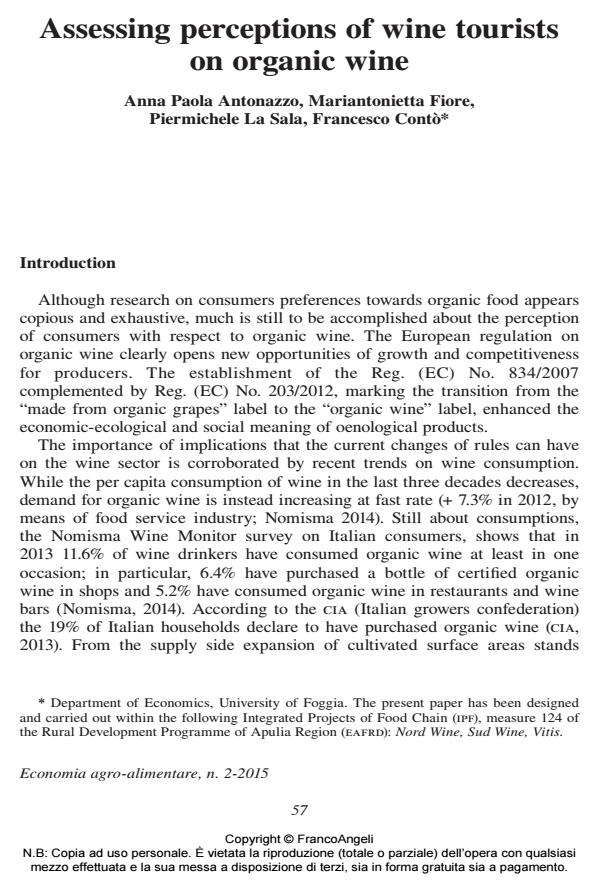Assessing perceptions of wine tourists on organic wine
Titolo Rivista ECONOMIA AGRO-ALIMENTARE
Autori/Curatori Anna Paola Antonazzo, Mariantonietta Fiore, Piermichele La Sala, Francesco Contò
Anno di pubblicazione 2015 Fascicolo 2015/2
Lingua Italiano Numero pagine 20 P. 57-76 Dimensione file 157 KB
DOI 10.3280/ECAG2015-002004
Il DOI è il codice a barre della proprietà intellettuale: per saperne di più
clicca qui
Qui sotto puoi vedere in anteprima la prima pagina di questo articolo.
Se questo articolo ti interessa, lo puoi acquistare (e scaricare in formato pdf) seguendo le facili indicazioni per acquistare il download credit. Acquista Download Credits per scaricare questo Articolo in formato PDF

FrancoAngeli è membro della Publishers International Linking Association, Inc (PILA)associazione indipendente e non profit per facilitare (attraverso i servizi tecnologici implementati da CrossRef.org) l’accesso degli studiosi ai contenuti digitali nelle pubblicazioni professionali e scientifiche
Wine consumption has, over the years, assumed an important cultural and social value which might be considered ‘hedonistic’. The evocativeness of wines lies in its recalling its territory of origin, and this function emerges especially among consumers who tend to travel in wine-producing regions. The establishment of the Reg. (EC) No. 834/2007 complemented by Reg. (EU) No. 203/2012 marking the transition from the "made from organic grapes" label to the "organic wine" label, enhanced the economic-ecological and social meaning of oenological products. Although the wine consumer focuses more on price, packaging and brand awareness, new trends in consumer preferences are moving towards innovative oenological products characterized by low sulfite and lower alcohol content. The purpose of this study is to assess perception of organic wine within a sample of consumers who are willing to travel to consume quality wine and to experience other particular attributes such as Protected Designation of Origin and region of origin, as well as price. The methodology consisted of Choice Experiments. The survey was conducted in June and July of 2013 in a region in the South of Italy. The data was collected during the "Calici di Stelle" event in Trani (Apulia), which is an annual wine tasting event aimed at fostering wine tourism in regions whose wine companies invest particularly in the high quality and sustainability of their products. We expect that organic certification labels will have a significant influence on the process of turning wine ‘credence’ attributes into ‘search’ attributes and could have a positive influence on the choice of a wine from the shelf. Filling the information gap in consumers’ perception of organic components may improve the competitiveness of local producers in the global market.
Parole chiave:Consumer perceptions, organic wine, choice experiments, wine-tourism, Conditional Logit Model Estimations
Jel codes:Q10, Q18, C25, D12, L83, Q10
- How to promote sustainable wine tourism: Insights from Italian and French young adults Riccardo Vecchio, Azzurra Annunziata, Tatiana Bouzdine-Chameeva, in Annals of Tourism Research Empirical Insights 100137/2024 pp.100137
DOI: 10.1016/j.annale.2024.100137 - Does organic means health for consumers? Selected issues of organic food market Nina Drejerska, Wioleta Sobczak, Jarosław Gołębiewski, Weronika Aniela Gierula, in British Food Journal /2021 pp.2622
DOI: 10.1108/BFJ-12-2020-1175
Anna Paola Antonazzo, Mariantonietta Fiore, Piermichele La Sala, Francesco Contò, Assessing perceptions of wine tourists on organic wine in "ECONOMIA AGRO-ALIMENTARE" 2/2015, pp 57-76, DOI: 10.3280/ECAG2015-002004